A week of miso soup, day 1: Zucchini miso soup
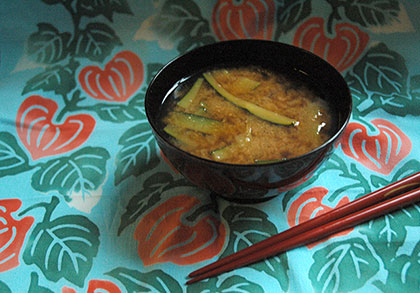
Continuing my series on Japanese home cooking, this week I would like to introduce different kinds of miso soup. Miso soup (misoshiru) is one of the key parts of a Japanese meal. Another kind of soup that is served often is a clear soup called osumashi, but the miso soup base is more adaptable to all kinds of variations.
The components of a miso soup are quite simple. It's based on a soup stock called dashi, with various ingredients cooked to different degrees in it. The miso is added at the very end of the cooking process.
I have gone over the making of dashi stock before (as well as the basics of miso soup), but it's always worthwhile going over it again - this time with pictures! I've given some vegetarian options for dashi also.
Today's miso soup is not quite traditional, but it's very easy to make with an ingredient that's easy to get practically anywhere. Besides, zucchini are very much in season right now, as anyone with a zucchini plant in their garden knows.
(If you haven't already, you may want to take a look at the essentials of a Japanese pantry, which has an explantion of the ingredients used.)
Traditional dashi stock
This is a basic and very delicious dashi stock, made with just two ingredients, pictured here.

The dark things are dried sheets of konbu seaweed that I have cut up with scissors for ease of use, and the stuff that looks like wood shavings is shaved dried bonito flakes. I store both double-bagged in plastic bags in the freezer.
Konbu is a large, thick leathery seaweed that is bursting with minerals. What makes it so ideal for making stock from is that it's packed with umami. Dried konbu will have a fine white powdery substance on the surface. Don't wash that off - that is full of umami! Some instructions may tell you to wipe off dirt from the konbu, but to be honest I haven't seen konbu with dirt on it for years, especially not on the dried, pre-packaged kind you are likely to find. If you taste it you will see that it is sort of like a much subtler version of MSG (monosodium glutamate) - not surprising, since MSG is actually chemically isolated umami.
Bonito is a kind of fish (called katsuo in Japanese); it's a popular sashimi item. A whole bonito fish side is slowly dried until it becomes a hard, woodlike block called katsuobushi. This is then shaved thinly. In my grandmother's time every household had a katsuobushi shaver, that sort of looked like a wood planer fixed on top of a box. My mother still prefers to shave her own, but I just use the pre-shaved kind that you see in the photo.
To make about 4 cups of dashi stock, you will need:
- 4 cups of cold water
- A 4 inch / 10 cm square piece (or small pieces adding up to that amount) of dried konbu
- About 1 cup (a handful) of bonito flakes
Keep in mind these are not exact amounts. Adding more konbu or more bonito flakes will just give it more flavor. Fans of the original Iron Chef TV series may recall Iron Chef Japanese Rokusaburo Michiba (the one who preceeded Iron Chef Morimoto in that role) adding huge handfuls of bonito flakes to his dashi pots.
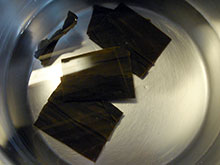 First, put your dried konbu and cold water into your pan, and leave it to soak for at least 20 minutes, preferably overnight. Don't wash off that white powder!
First, put your dried konbu and cold water into your pan, and leave it to soak for at least 20 minutes, preferably overnight. Don't wash off that white powder!
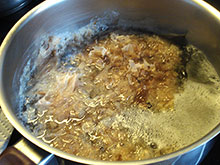 After the soaking time, bring the water up to a boil, throw in the bonito flakes, and turn off the heat. Leave to steep for a few minutes, then strain through a sieve.
After the soaking time, bring the water up to a boil, throw in the bonito flakes, and turn off the heat. Leave to steep for a few minutes, then strain through a sieve.
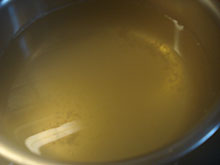 Your dashi will be a pale golden yellow in color, and ready to use.
Your dashi will be a pale golden yellow in color, and ready to use.
Note: if you are frugal, you can keep the used konbu and bonito flakes to make nibandashi from them - a thinner dashi that is fine for use in stewed dishes like nikujaga (Japanese meat and potatoes). Put in a plastic bag or container, and refrigerate for up to 3 days (or freeze) until ready to use.
Alternative ways of making non-vegetarian dashi
The easiest way is to just use dashi stock granules. I always have a box of this around since it's so handy. The amount to use depends on the brand, but generally it's about 1 teaspoon to 4 cups of water. Two brands that are widely available are Ajinomoto Hondashi and Shimaya Dashinomoto; to me they are virtually indistinguishable, though the Hondashi may have slightly more bonito aroma. Do keep in mind that dashi made from granules is saltier than dashi made from natural ingredients, so you will need to adjust the amount of miso soup you put in later. (See also health considerations - most dashi stock granule brands contain MSG.)
In some Japanese households, small dried fish called niboshi are used in stock instead of bonito flakes. You simply throw a few of them into the pot with the konbu, and let it simmer a bit. I have a bag of powdered niboshi, which can be used just like dashi granules. Some people object to dashi made from niboshi, considering it to be too fishy tasting. I don't mind it myself but I do prefer bonito flakes.
Vegetarian dashi
Use my basic vegetarian (vegan) dashi stock recipe. Alternatively, you can use vegetable stock cubes - the flavor won't be totally authentic, but will still add plenty of flavor.
What kind of miso to use
There are basically 2 kinds of miso widely available outside of Japan: white or yellow-brown, and red. For miso soup, I mostly use white miso (shiromiso) or awasemiso (blended miso). See the Japanese pantry list for more about miso.
Making miso soup
The key thing to remember when making miso soup is that the miso is always added last. Miso is quite heat-sensitive, and boiling it vigorously will really affect the flavor and texture adversely. Over-boiled miso soup takes on a rather grainy quality. The only things you can add after adding the miso are things that cook instantly, such as baby spinach leaves.
So, let's make a very simple miso soup.
Zucchini miso soup
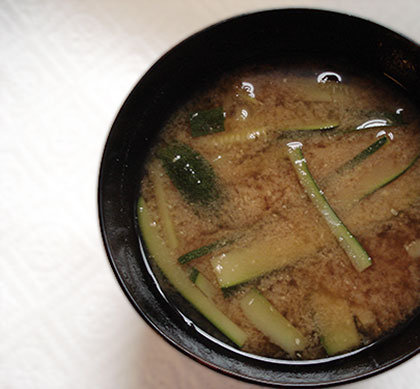
- 4 cups of dashi stock, prepared as above using your preferred method
- 1 cup zucchini, cut into thin strips (about 1 small zucchini)
- 1/4 to 1/3 cup white or blended miso (see notes)
Bring the dashi stock to a boil, and add the zucchini. Simmer until the zucchini is tender, about 5 minutes.
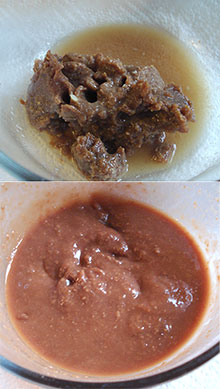 Put the miso into a small cup. Add a little of the hot dashi stock, and mix around with chopsticks or a fork until the miso is dissolved into a smooth paste. (The picture on top shows the miso before it's dissolved, and the one below shows it after.) Add to the soup. Taste the soup, and add a little more miso if it seems too weak for you. (I actually do this mixing with dashi part in the soup ladle, but a cup may be easier to handle if you aren't used to it.)
Put the miso into a small cup. Add a little of the hot dashi stock, and mix around with chopsticks or a fork until the miso is dissolved into a smooth paste. (The picture on top shows the miso before it's dissolved, and the one below shows it after.) Add to the soup. Taste the soup, and add a little more miso if it seems too weak for you. (I actually do this mixing with dashi part in the soup ladle, but a cup may be easier to handle if you aren't used to it.)
Bring the soup back up to heat, then switch off. Serve immediately.
Notes:
- If you are serving miso soup as part of a Japanese meal centered on white rice, make it a bit stronger in taste; if you are serving it as a separate course, hold back a bit on the amount of miso used. Always taste to make sure you have added the amount that's right for you.
- Miso has a natural tendency to separate from the water/dashi, especially as it cools. If this happens to you, don't worry, just mix up the soup a bit.
If you enjoyed this article, please consider becoming my patron via Patreon. ^_^

 Welcome to Just Hungry, where we serve authentic Japanese recipes and more! I'm
Welcome to Just Hungry, where we serve authentic Japanese recipes and more! I'm 












Comments
Cyndi
29 August, 2006 - 06:02
Permalink
A week of miso soup, day 1: Zucchini miso soup
Maki, I'm so glad I discovered your blog - I know almost NOTHING about Japanese cooking, and your blog is where I go to learn. Some things I like, some I don't - but it's all fun learning about it!
maki
29 August, 2006 - 22:18
Permalink
A week of miso soup, day 1: Zucchini miso soup
Cyndi, I'm glad it's useful to you! let me know what you do and don't like too - that helps me write better articles!
Genevieve
9 October, 2006 - 09:00
Permalink
A week of miso soup, day 1: Zucchini miso soup
what a wonderful guide to miso. i just made some but was lazy and skipped the konbu. not going to do that next time...
a
26 September, 2007 - 12:18
Permalink
justanother miso question . . .
From some of your comments about Ajinomoto stock, you share my concerns about consuming an excess amount of MSG. However, as far as I understand, most brands of miso paste contain a large amount -- Marukome's Ryou-tei is the type I usually buy [ http://www.marukome.co.jp/product/nama/ryo-tei.html ] and this seems to be the most easily available.
Are there any brands of additive free miso paste you know of? Which brand do you recommend / usually use?
Any info appreciated.
Kind regards.
a
maki
26 September, 2007 - 13:46
Permalink
look for miso without added dashi
You will want to look for miso that doesn't have dashi added to it. That Marukome miso does have dashi added, which is where the MSG is probably. I don't really stick to any particular brand, but at the moment I have a box of Shinshuu Miso and another one of a brown rice miso that comes from Hokkaido. The Shinshuu Miso just lists soy beans, salt, rice and kouji (rice-based yeast). Actually, the Marukome site does list some 'no additives' or mutenka miso too here.
anon.
30 September, 2007 - 16:48
Permalink
Freezing Miso Soup
I made a miso soup with vegetables and tofu, can I freeze the already made soup?
maki
30 September, 2007 - 20:54
Permalink
freezing tofu
When you freeze tofu, the texture changes quite a bit and becomes sort of like a sponge. If you don't mind that I guess you can freeze miso soup.
Pat
3 October, 2007 - 21:28
Permalink
freezing tofu
I read on House Tofu's website that you should never freeze tofu. I accidentally froze some leftover tofu once, and next day when I took it out, it looked EXACTLY like raw chicken meat! Not very appetizing so I tossed it out.
maki
4 October, 2007 - 09:52
Permalink
frozen tofu
Actually, there's a product called kouya dofu (or kouya tofu) which is purposefully frozen, then dried, tofu. It's sort of like one of those sponges that you soak in water to use. It is beige, and spongy in texture, but it's not bad in soups or cooked in a broth once it's rehydrated. And since it's dried it keeps for a long time, unlike fresh tofu of course.
Here's a picture on the Japan Centre site.
Peter Scott
18 February, 2008 - 22:51
Permalink
Great Recipe!
Thanks for the great recipe. I finally made good miso soup! I would only add that in order to keep the good flora alive in the miso(digestive benefits like yogurt etc.), it is important not to ever let it come it a boil. I try to make the tofu float just as the pot starts to simmer then I quickly remove the pot to a cooler burner. Likewise for the konbu - my Japanese friend said to put it in the water cold, soak for a few minutes and then bring the temp up slowly over about 45 minutes, just to a simmer and without boiling. I am slowly getting the taste right.
Marissa
1 July, 2008 - 06:58
Permalink
oooh yum
you're instructions are so so clear. I can't wait to try this I absolutely adore miso soup.
M.R.
7 November, 2008 - 00:21
Permalink
So hard to find goo aulternatives...
Admittedy, my first try around my wakeme was too chewy yet, and my Tofu was more gummy than i'd expected...
No store near my home sells Dashi... at all.
I tried it with vegi stock, as you suggested. I also used diluted chicken stock.
Thanks for the awesome article... It gave me soe great ground work to build off of!
M.R.
7 November, 2008 - 00:21
Permalink
So hard to find goo aulternatives...
Admittedy, my first try around my wakeme was too chewy yet, and my Tofu was more gummy than i'd expected...
No store near my home sells Dashi... at all.
I tried it with vegi stock, as you suggested. I also used diluted chicken stock.
Thanks for the awesome article... It gave me soe great ground work to build off of!
Bear
25 March, 2009 - 17:24
Permalink
Re: A week of miso soup, day 1: Zucchini miso soup
As a German/Scotch/English, I was fortunate to grow up with pair of Chinese/Irish boys who had a first generation Chinese grandmother, who adopted me like I was her own and fed me everything she fed the family. I found a love for Asian cooking which has lasted a lifetime, but she only knew a couple of English phrases ("you eat!", "you like?") so she couldn't explain many of the intricacies of what she was making and the boys could care less about translating, so I was unable to carry on her food legacy.
Thank you so much for helping me rediscover that legacy and begin filling in the knowledge and rekindle the passion that was the gift from her kitchen to mine.
Bear
jennythenipper
13 May, 2009 - 19:31
Permalink
Re: A week of miso soup, day 1: Zucchini miso soup
Love this idea of a week of Miso soups. I'm going to work these into my week-end lunches.
You rock!
Jenny
13 July, 2009 - 17:13
Permalink
Re: A week of miso soup, day 1: Zucchini miso soup
HI Maki!
Fist of all, thnaks a lot for your site! I bought tororo Kombu and it does not look at all like the kombu you are presenting in your picture. Do you think it might still work for dashi stock? It dissolved when i put it in the water. I'm not sure what to expect since its my first atempt ar miso soup. thanks Jenny
christo
14 April, 2010 - 19:26
Permalink
Re: A week of miso soup, day 1: Zucchini miso soup
i've always loved miso soup at japanese restuarants; but never had the inspiration to make my own. your inspiring recipe did the trick and has got me making my own. thanks! - christo
Joe Marfic
8 June, 2010 - 15:53
Permalink
Re: A week of miso soup, day 1: Zucchini miso soup
Thanks for this delightful post! It's chock-full of handy little bits of info that most miso soup recipes don't mention.
anon.
20 June, 2010 - 12:53
Permalink
Re: A week of miso soup, day 1: Zucchini miso soup
Very helpful site. I love miso. Did you realise you wrote miroshiru instead of misoshiru at the start of the article?
Noa
20 June, 2010 - 19:39
Permalink
Re: A week of miso soup, day 1: Zucchini miso soup
What a delightful and very informative post!
I'm going to make some miso now, wish me luck...
Shreeja N
30 August, 2011 - 15:17
Permalink
Nice soup recipe! Konbu and
Nice soup recipe! Konbu and bonito flakes, I found at the local supermarket after much searching.Will try this out coming weekend.tc ;)
Valerie
26 September, 2011 - 03:24
Permalink
Delicious and light!
Hi Maki! I hope you are feeling better. I just made this soup with your Nappa cabbage tsukemono and a salmon & egg donburi for dinner. I am not sure if that combination of flavors is traditionally appropriate, but I was going for sweet, spicy, and savory.
I was surprised that the soup was as sweet as it is, but I guess I shouldn't have been. It was very good and will definitely grace my table again. Thank you for sharing it!
Katie
18 July, 2012 - 02:43
Permalink
Re: A week of miso soup, day 1: Zucchini miso soup
Thank you so much for the ideas! I was led here by your article on instant miso soup balls and the zucchini miso looks delicious. I didn't have any on hand, but I had a few garden-fresh yellow squash and decided to wing it:
1 egg
2 small yellow squash (just the flesh)
mystery seaweed/mushroom mix (got it from a Chinese friend- she just said it was "soup")
1 spoon miso
5-spice powder
1 beef bullion cube
Onion powder
Emeril's Essence
Soy to taste
... I think this is the first time I've felt comfortable enough with "eastern" ingredients to throw something together. I have you to thank for most of it Maki! <3